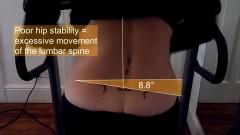 Sciatica is caused by irritation of the sciatic nerve, often as it passes through the joints of the back or structures of the pelvis and buttock. This can be caused by injury to the discs between the bones of the back or by problems with the joints of the back. Sciatica can also be caused by problems as the nerve passes through the muscles of the buttock. These muscles can become dysfunctional as a result of back pain, pain from the sacroiliac joint or muscle imbalance. So a thorough assessment is really important in order to be clear as to the correct diagnosis. Sometimes we may video movements, such as walking and running, so they can be watched back frame-by-frame to get a really good understanding of an individuals movement patterns (see video below).
Sciatica is caused by irritation of the sciatic nerve, often as it passes through the joints of the back or structures of the pelvis and buttock. This can be caused by injury to the discs between the bones of the back or by problems with the joints of the back. Sciatica can also be caused by problems as the nerve passes through the muscles of the buttock. These muscles can become dysfunctional as a result of back pain, pain from the sacroiliac joint or muscle imbalance. So a thorough assessment is really important in order to be clear as to the correct diagnosis. Sometimes we may video movements, such as walking and running, so they can be watched back frame-by-frame to get a really good understanding of an individuals movement patterns (see video below).
Once the cause is established it can be treated with the appropriate strategy, which may include:
Joint manipulation… This can be a very effective form of treatment in lots of cases and there is a growing body of evidence to help us identify which patients are likely to respond best to manipulation. These patients can be identified at assessment, and respond very well to manipulation, especially when accompanied by a home exercise program to promote flexibility and strength.
Soft tissue treatment and trigger point release… There is good evidence to suggest that myofascial or soft tissue treatment performed by a qualified practitioner is highly effective at reducing pain and promoting recovery in patients with recent and long term back pain. Often when assessing patients with back pain it is easy to feel spasm and ‘knots’ in muscle tissue. These knots are exquisitely painful, but with appropriate treatment these areas become soft and pain-free. Often, the longer the pain has been present the more areas of muscle spasm are present. This treatment must be accompanied by an exercise program to improve control, flexibility and strength.
Assessment of biomechanics… If there are certain activities, movements or postures that provoke your pain it is important to look at these activities in order to assess how you perform them. Often, making small adaptations to the way we move can help make a painful activity comfortable. At the initial assessment, by observing how you move and feeling the way your spine moves, we can identify any areas of excessive stiffness or any areas that are excessively mobile. By understanding the biomechanics of movement we can help you to understand that by subtly changing the way you move it is possible to reduce the stress on painful tissue, which will result in a noticeable reduction in your pain, and allow them to heal. This may be done by changing the way you bend or move.



